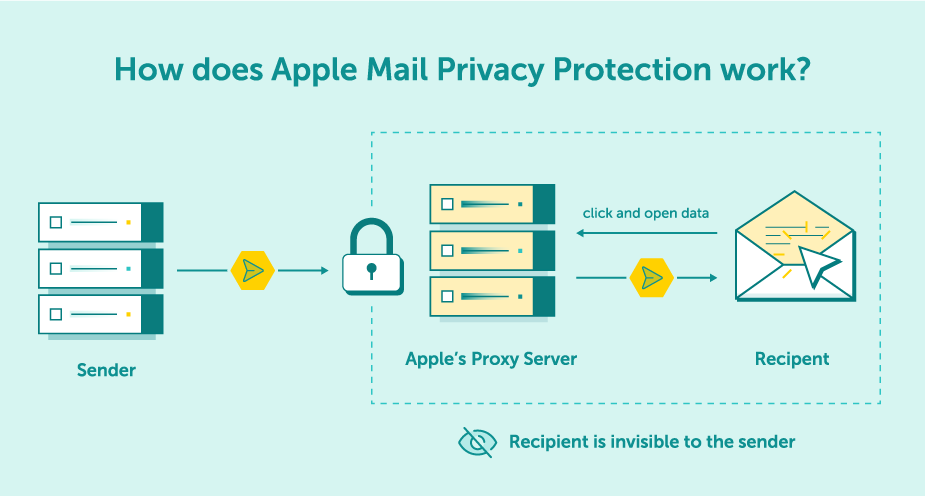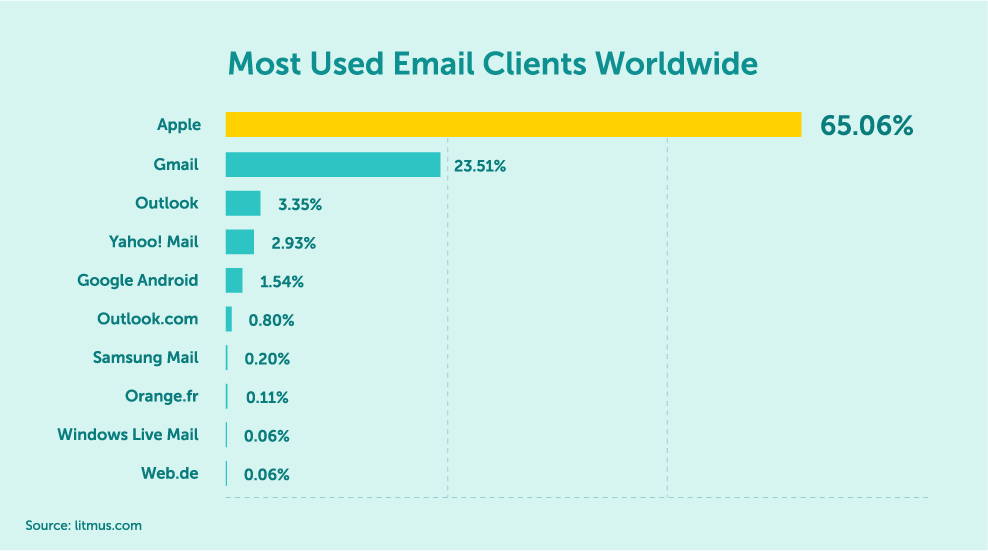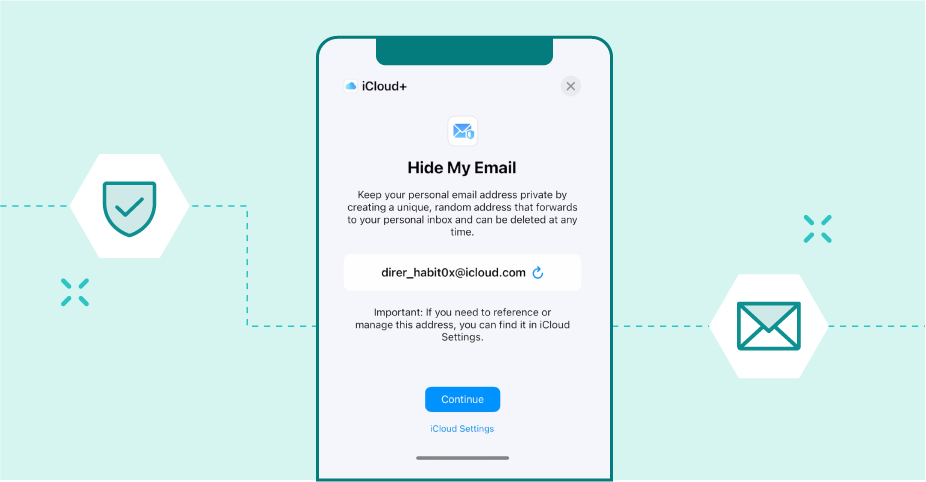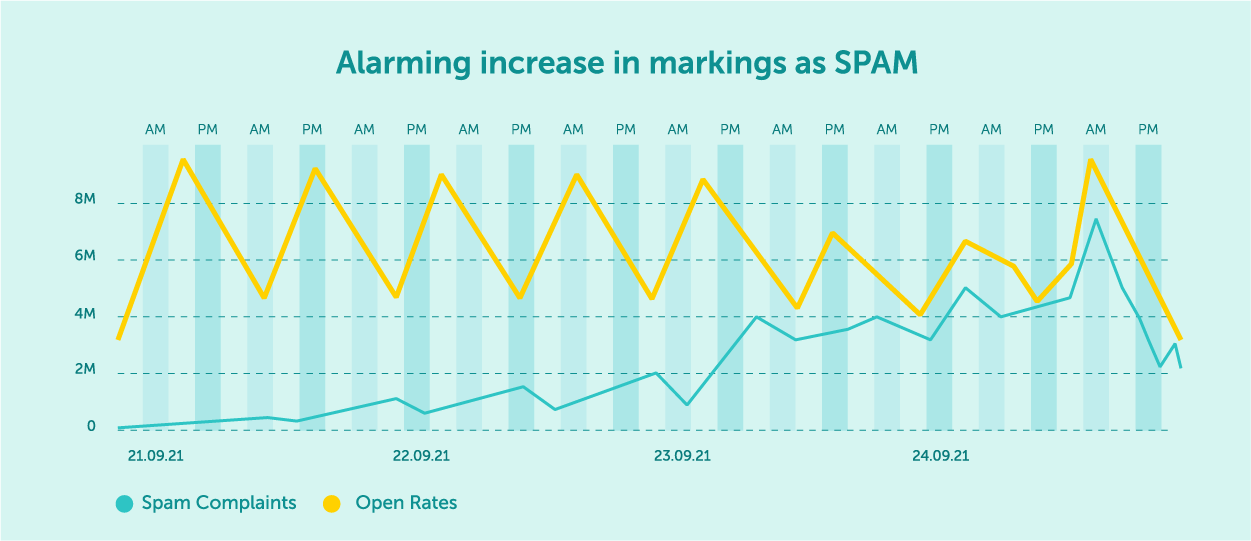
Although the new privacy policy for Apple users was already introduced in September 2021 (with the launch of iOS 15 and macOS Monterey), its impact on email opens and other metrics to track the activity of recipients who use the Mail app on Apple devices and have enabled MPP, increases with each passing day. More and more senders are seeing a worrying increase in the open rate when analyzing their results, yet until recently this indicator was an irreplaceable one when determining the winner of A/B tests, was the trigger for scenarios in marketing automation, and which, for many marketers, is still the only metric for evaluating the engagement of recipients and the effectiveness of the campaign.
MPP stands for Mail Privacy Protection in the Mail app on iPhone, iPad or Mac devices, which was introduced to prevent senders (including Apple) from gaining information about users’ activities such as:

When a sender sends an email to an MPP user, Apple downloads remote content, including tracking pixels on its own servers. This action looks like opening the email, even though the end user may not have opened the message.
The opening of a message is registered, among other things, when a tracking pixel (a small, invisible image – usually 1×1 in size) embedded in HTML is downloaded from the server.
By default, the Privacy Protection in the Mail app on Apple devices routes all remote content of the email in the background through two independent relays operated by different entities. The first knows the IP address of the device but has no insight into the content of the messages. The second knows what remote content is being downloaded, but does not know the exact location of the device (IP address). The sender’s server, therefore, receives the recipient’s generalized identity and location regardless of interaction with the email, and therefore not when the recipient actually opens the message. This in turn makes the open rate falsely increased and makes it difficult to identify subscribers who are truly engaged and reading the messages they receive.
Maximize your email deliverability and security with EmailLabs!
Due to their easy failure rate, replacing a phone with a newer model often occurs after only a few months of use. Even if we use the same device all the time, tempted by new features or for security reasons, we carry out the latest software updates as soon as they become available.

When users open the Apple Mail app for the first time after downloading the latest iOS operating system, they are prompted to choose whether to protect their privacy.
When users open the Mail app for the first time after downloading the latest iOS operating system, they are prompted to choose whether they want to protect their privacy. It is for this reason that there has recently been a significant increase in the number of users choosing to launch MPP – and therefore a higher open rate compared to previously received results – many of whom have upgraded or purchased new devices. Senders who were seeing open rates of around 20% prior to the introduction of MPP are now seeing increased OR – up to 70% are false opens, triggered when graphics are downloaded by Apple’s servers.
Please note that MPP is not automatically activated on recipients’ devices – users must activate this feature on their phones.
This can be done at any time directly in the device settings. On an iPhone, go to Mail > Privacy > Protect Mail activity and then select whether you want to both hide your IP address and Protect Mail Activity, or enable only one of the above privacy features. On a Mac, open Mail > Preferences > Privacy and select Protect Mail Activity.
Senders with US customers in their contact database are at greater risk of inflated open rates due to the significant share of Apple users in this market. Many are seeing results of almost 100% for iCloud (@icloud.com, @me.com or @mac.com domains) which seems obvious as iPhone users are more likely to use Apple Mail.
However, it is worth noting that the increase in OR may also apply to other email addresses, including Gmail, Yahoo, Microsoft etc. if these are configured in the Mail app on Apple devices. That said, Gmail users are less inclined to connect their mailboxes to other solutions, so those false opens should affect these recipients to a lesser extent.

Apple Mail used by more than half of the world’s email users to send and receive emails.
At this point, it would also be worth mentioning the “Hide my email” functionality. iCloud+ subscribers can generate unique, random email addresses on demand in the Mail app to keep their real email addresses private. These can be used when subscribing to newsletters or entered in registration forms on websites. When such an address is no longer needed – simply deactivate it. This is worth bearing in mind, as it may also affect the reliability of the results.

“Hide my email address” function allows us to generate unique, random email addresses that redirect messages sent to them to our personal inbox (to our “real” email address).
Maximize your email deliverability and security with EmailLabs!
If you are keeping your contact database clean and up-to-date, you are probably removing the addresses of subscribers who have not read emails for a long time based on opens. As every message addressed to MPP users will have a reported opening, eliminating unengaged recipients will be far more difficult. Recipients may receive significantly more unsolicited mail than they did in the pre-MPP era – which could be reflected in an increased number of Spam markings (Spam Complaints rate) or Abuse reports.
Even before Apple announced the change in the privacy policy, many senders considered open rates to be an unreliable measure of audience engagement and clicks began to be tracked as the preferred metric. This is a good thing, as clicks provide a more accurate measurement than opens – as they signify intentional activity on the part of the recipient. The disadvantage is that they are fewer and generated less frequently. Even if an email is opened and read, the recipient may close it or delete it immediately. Therefore, a strategy should be prepared to encourage clicks, e.g. through prominent CTA buttons that call for action – directing to a website or mobile app.
Is it worth continuing to look at open rate as the main email campaign performance metric?
Completely replacing the open rate with the click rate is not ideal. It is still worth keeping an eye on the first indicator – but as a variable measured over time – taking a closer look at any noticeable fluctuation. Analysis of opens should be conducted in comparison to other metrics. If we observe an increased number of opens and an increase in spam complaints, we get a clear signal that the campaign was not well prepared – perhaps the subject line of the message misled the recipients.

The increased number of opens and the concomitant increase in marking messages as spam is a clear sign that the campaign was not well prepared.
By anonymizing open tracking, Apple has made it impossible for senders to understand how MPP users are engaging with a particular email campaign. While it is still possible to track clicks or the number of Spam Complaints, identifying unengaged contacts or assessing the effectiveness of a mailing without an Open Rate is far more difficult.
Marketers need to find the golden mean and, instead of focusing solely on opens, also look at other metrics with which to measure the success of the campaigns. In this way, the inflated and volatile numbers caused by the MPP will no longer have as much impact on the way they monitor their mailings.
The increasing number of phishing attacks each year, and the projection that this trend will continue to escalate, aren’t likely to astonish anyone. This can be attributed, in part,...
With the emergence of the Covid-19 pandemic, many brands have been challenged to adapt in a short period to the changed reality and new consumer attitudes. That meant reorganizing...
If you’re sending more than 5,000 emails a day, you need to pay attention. Microsoft just dropped a major announcement that’s going to change how your emails get delivered....
Best practices, Email Authentication
Email headers may seem like a cloud of confusion, but fear not! In this ultimate guide, we will break down email headers and make them crystal clear. We’ll start...
Does your inbox feel like a never-ending to-do list? Are you spending more time sorting emails than actually working? You’re not alone. Millions of professionals struggle with email overload,...
We are delighted to announce that Vercom S.A., the company behind the EmailLabs project, has successfully completed the ISO 22301 certification process. This significant achievement underscores our commitment to...
EmailLabs, as part of the Vercom group, proudly announces its full commitment to aligning its ICT services with the latest cybersecurity standards. In response to dynamically changing regulations, the...
Best practices, Compliance & Security
As we step closer to a digitally connected future, ensuring inclusivity in our marketing strategies is more important than ever. Email, a cornerstone of digital communication, must evolve to...
We are pleased to announce that MessageFlow, a product from the Vercom S.A. group, has received the prestigious CSA (Certified Senders Alliance) Certification. This recognition not only underscores the...
The increasing number of phishing attacks each year, and the projection that this trend will continue to escalate, aren’t likely to astonish anyone. This can be attributed, in part,...
With the emergence of the Covid-19 pandemic, many brands have been challenged to adapt in a short period to the changed reality and new consumer attitudes. That meant reorganizing...
If you’re sending more than 5,000 emails a day, you need to pay attention. Microsoft just dropped a major announcement that’s going to change how your emails get delivered....
Best practices, Email Authentication
Email headers may seem like a cloud of confusion, but fear not! In this ultimate guide, we will break down email headers and make them crystal clear. We’ll start...
Does your inbox feel like a never-ending to-do list? Are you spending more time sorting emails than actually working? You’re not alone. Millions of professionals struggle with email overload,...
We are delighted to announce that Vercom S.A., the company behind the EmailLabs project, has successfully completed the ISO 22301 certification process. This significant achievement underscores our commitment to...
EmailLabs, as part of the Vercom group, proudly announces its full commitment to aligning its ICT services with the latest cybersecurity standards. In response to dynamically changing regulations, the...
Best practices, Compliance & Security
As we step closer to a digitally connected future, ensuring inclusivity in our marketing strategies is more important than ever. Email, a cornerstone of digital communication, must evolve to...
We are pleased to announce that MessageFlow, a product from the Vercom S.A. group, has received the prestigious CSA (Certified Senders Alliance) Certification. This recognition not only underscores the...
The increasing number of phishing attacks each year, and the projection that this trend will continue to escalate, aren’t likely to astonish anyone. This can be attributed, in part,...
We are delighted to announce that Vercom S.A., the company behind the EmailLabs project, has successfully completed the ISO 22301 certification process. This significant achievement underscores our commitment to...
Do you ever wonder how many people actually open the emails you send? Knowing the number of people who open your emails is essential for understanding the effectiveness of...
Gmail has become a cornerstone of modern email communication, offering a dynamic platform that caters to both personal and professional needs. Since its inception in 2004, Gmail has consistently...
EmailLabs, as part of the Vercom group, proudly announces its full commitment to aligning its ICT services with the latest cybersecurity standards. In response to dynamically changing regulations, the...
Email deliverability is a cornerstone of effective digital marketing. It ensures that your carefully crafted messages reach the intended recipients’ inboxes rather than being relegated to spam folders. Google...
If you’re sending more than 5,000 emails a day, you need to pay attention. Microsoft just dropped a major announcement that’s going to change how your emails get delivered....
Best practices, Email Authentication
Email headers may seem like a cloud of confusion, but fear not! In this ultimate guide, we will break down email headers and make them crystal clear. We’ll start...
Does your inbox feel like a never-ending to-do list? Are you spending more time sorting emails than actually working? You’re not alone. Millions of professionals struggle with email overload,...
Apple Mail, Email Marketing, Gmail
Efficient email management has become a necessity in today’s digital world. To address this need, email services categorize incoming messages into different tabs or folders, helping users streamline their...
We are delighted to announce that Vercom S.A., the company behind the EmailLabs project, has successfully completed the ISO 22301 certification process. This significant achievement underscores our commitment to...
Do you ever wonder how many people actually open the emails you send? Knowing the number of people who open your emails is essential for understanding the effectiveness of...
Gmail has become a cornerstone of modern email communication, offering a dynamic platform that caters to both personal and professional needs. Since its inception in 2004, Gmail has consistently...
EmailLabs, as part of the Vercom group, proudly announces its full commitment to aligning its ICT services with the latest cybersecurity standards. In response to dynamically changing regulations, the...
Email deliverability is a cornerstone of effective digital marketing. It ensures that your carefully crafted messages reach the intended recipients’ inboxes rather than being relegated to spam folders. Google...
If you’re sending more than 5,000 emails a day, you need to pay attention. Microsoft just dropped a major announcement that’s going to change how your emails get delivered....
Best practices, Email Authentication
Email headers may seem like a cloud of confusion, but fear not! In this ultimate guide, we will break down email headers and make them crystal clear. We’ll start...
Does your inbox feel like a never-ending to-do list? Are you spending more time sorting emails than actually working? You’re not alone. Millions of professionals struggle with email overload,...
Apple Mail, Email Marketing, Gmail
Efficient email management has become a necessity in today’s digital world. To address this need, email services categorize incoming messages into different tabs or folders, helping users streamline their...
We are delighted to announce that Vercom S.A., the company behind the EmailLabs project, has successfully completed the ISO 22301 certification process. This significant achievement underscores our commitment to...